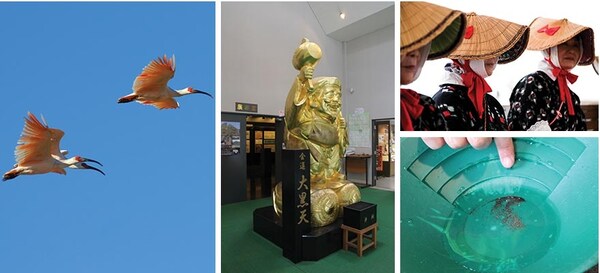Sado: Isle of Gold, Sake & Natural Wonders

http://www.gov-online.go.jp/eng/publicity/book/hlj/html/201407/201407_12_en.html
An S-shaped island in the Sea of Japan, Niigata Prefecture's Sado is Japan's sixth largest island after its four main islands and Okinawa. Since the eighth century, Sado's remoteness from the mainland made it an appropriate place for exiles. Now, however, the island is easily reachable by ferry from Niigata Port. With a population of about 60,000 people, Sado abounds with nature and hosts a sanctuary for the endangered crested ibis, or toki in Japanese.
Upon arriving at Sado's Ryotsu Port, we rented a car and headed off to our first destination, Sado Nishimikawa Gold Park. Sado has a long history of gold in its mountains and rivers that spans more than 1,000 years. Visitors can learn about that history before panning for the precious metal itself. Gold panning is a popular activity for would-be miners of all ages because they can take home whatever gold they find during the allotted time in a souvenir keepsake bottle.
The Gold Park offers three levels of difficulty: the beginner level is a waist-high trough, while the intermediate level has visitors crouching down at a small artificial stream. The third and most challenging option is to pan directly in the river below the facility. Hidekazu Chuzenji, the Gold Park's head of sales, assured us that visitors will usually turn up gold at the first two levels as long as they perform the technique properly. Sure enough, sifting out the sediment in our pans revealed small flakes of the glimmering yellow metal.
Next we headed down to Ogi Port, which is famous for tarai-bune—unique, tub-shaped wooden boats traditionally propelled by a single paddle. Reportedly first used in the Meiji Era (1868-1912) to help fishermen gather shellfish and seaweed near rocky areas, local fishermen still use them today, albeit with the convenient addition of outboard motors.
Visitors can experience a ride in a traditional tarai-bune steered by a colorfully dressed local woman. Each boat accommodates up to three passengers, and depending on the weather and condition of the waves around the port, visitors may also try their hand at the helm.
Finally, no visit to Niigata Prefecture would be complete without trying the local sake. The prefecture is renowned for its clean mountain water and delicious rice, crucial ingredients to sake production. Sado's very own Manotsuru brand, produced by Obata Shuzo Co., Ltd., is making a name for itself even outside of Japan. Obata Shuzo offers free sake tastings and samples of other nonalcoholic products at their brewery, which is open daily and year-round.
Read full story: www.gov-online.go.jp



